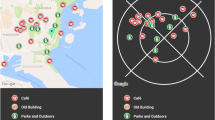Abstract
Electronic tourist guide systems typically recommend locations and sometimes provide navigation information. However, previously such systems were rather naive about what constituted information close to and thus relevant for the user. In this paper we show how to exploit knowledge about features in the real world to compute whether an information resource concerns something that the user can probably see. At run-time, we can take a set of foci, that is 2D polygons to which data is attached, and then filter away those foci that are invisible because they are occluded by nearby buildings. This is performed with the awareness of the inconsistencies and lack of accuracy in both mapping technology and GPS positioning in urban spaces. We have also developed tools to upload geotagged photos and mark foci polygons on a map. Using visibility-filtered information, less cluttered maps can be provided, and the user experience enhanced through removal of irrelevant information.









Similar content being viewed by others
References
Mapserver. Web Resource—verified 15-02-2005. http://www.mapserver.gis.umn.edu
Uk ordinance survey. Web Resource—verified 15-02-2005. http://www.ordnancesurvey.co.uk/oswebsite
Abbot E, Powell D (1999) Land-vehicle navigation using gps. Proc IEEE 87(1):145–162
Agrawala M, Stolte C (2001) Rendering effective route maps: improving usability through generalization. In: Fiume E (ed) SIGGRAPH 2001, computer graphics proceedings. ACM Press/ACM SIGGRAPH, pp 241–250
Angermann M, Robertson P, Strang T (2005) Issues and requirements for Bayesian approaches in context aware systems. In: Lecture notes in computer science, vol 3479. Springer, Berlin Heidelberg New York, pp 235–243
Bandini S, Mosca A, Palmonari M (2005) Commonsense spatial reasoning for context-aware pervasive systems. In: Lecture notes in computer science, vol 3479. Springer, Berlin Heidelberg New York, pp 181–188
Benford S, Bowers J, Chandler P, Ciolfi L, Flintham M, Fraser M, Greenhalgh C, Hall T, Hellstrom S-O, Izadi S, Rodden T, Schnadelbach H, Taylor I (2001) Unearthing virtual history: using diverse interfaces to reveal hidden virtual worlds. Ubicomp 2001:225–231
Benford S, Seagar W, Flintham M, Anastasi R, Rowland D, Humble J, Stanton D, Bowers J, Tandavanitj N, Adams M, Farr JR, Oldroyd A, Sutton J (2004) The error of our ways: the experience of self-reported position in a location-based game. Ubicomp 2004
Brown B, Chalmers M, Bell M, MacColl I, Hall M, Rudman P (2005) Sharing the square: collaborative visiting in the city streets. In: Proceedings of ECSCW 2005, Paris, France. Springer, Berlin Heidelberg New York, pp 427–429
Buchholz T, Linnhoff-Popien C (2005) Towards realizing global scalability in context-aware systems. In: Lecture notes in computer science, vol 3479. Springer, Berlin Heidelberg New York, pp 26–39
Castro P, Chiu P, Kremenek T, Muntz R (2001) A probabilistic location service for wireless network environments. In: UbiComp 2001. Springer, Berlin Heidelberg New York, pp 18–24
Chalmers M (2000) Cookies aren’t enough: tracking and enriching web activity with recer. Preferred placement: knowledge politics on the web, pp 99–102
Cheverst K, Davies N, Mitchell K, Friday A, Efstratiou C (2000) Developing a context-aware electronic tourist guide: some issues and experiences. In: CHI 2000, ACM Press, pp 17–24
Cohen-Or D, Chrysanthou Y, Silva C, Durant F (2003) A survey of visibility for walk-through applications. IEEE Trans Vis Comput Graph 9(3):412–431
Espinoza F, Persson P, Sandin A, Nystrm H, Cacciatore E, Bylund M (2001) Social and navigational aspects of location-based information systems. In: Abowd, Brumitt, and Shafer (eds) UbiComp 2001. Springer, Berlin Heidelberg New York, pp 2–17
Hariharam R, Krumm J, Horvitz E (2005) Lecture notes in computer science, vol 3479. Springer, Berlin Heidelberg New York. Web-enhanced GPS, pp 95–104
Kray C, Kortuem G (2004) Interactive positioning based on object visibility. Mobile HCI 04:276–287
Lane G (2003) Urban tapestries: wireless networking, public authoring and social knowledge. Pers Ubiquitous Comput 7(3–4):169–175
Schilit B, LaMarca A, Borriello G, Griswold W, McDonald D, Lazowska E, Balachandran A, Hong J, Iverson V (2003) Challenge: ubiquitous location-aware computing and the place lab initiative. In: The first ACM international workshop on wireless mobile applications and services on WLAN (WMASH 2003), pp 29–35
Steed A (2004) Supporting mobile applications with real-time visualisation of gps availability. Mobile HCI 2004:373–377
Steed A, MacColl I, Randell C, Brown B, Chalmers M, Greenhalgh C (2004) Models of space in a mixed-reality system. Inf Vis 2004:768–777
Toyama N, Ota T, Kato F, Toyota Y, Hattori T, Hagino T (2005) Exploiting multiple radii to learn significant locations. In: Lecture notes in computer science, vol 3479. Springer, Berlin Heidelberg New York, pp 95–104
Acknowledgements
This work was supported by the UK projects, EQUATOR Interdisciplinary Research Collaboration (EPSRC Grant GR/N15986/01) and Advanced Grid Interfaces for Environmental e-science in the Lab and in the Field (EPSRC Grant GR/R81985/01). The vector data used was supplied by the UK Ordnance Survey.
Author information
Authors and Affiliations
Corresponding author
Rights and permissions
About this article
Cite this article
Beeharee, A., Steed, A. Exploiting real world knowledge in ubiquitous applications. Pers Ubiquit Comput 11, 429–437 (2007). https://doi.org/10.1007/s00779-006-0091-6
Received:
Accepted:
Published:
Issue Date:
DOI: https://doi.org/10.1007/s00779-006-0091-6




